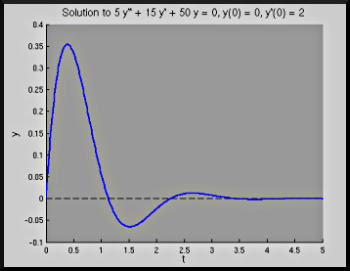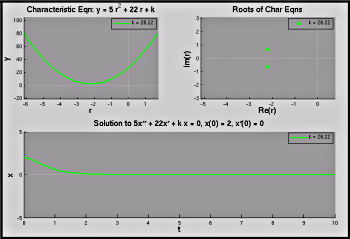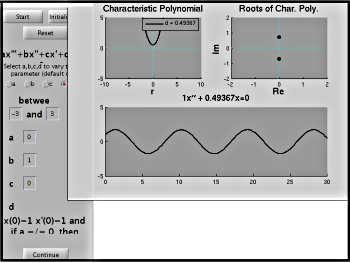Abstract
The model used here anticipates mass-spring-dashpot models, being equivalent and providing a different look at those. The solution of the differential equation can be undertaken by considering the standard exponential form, and exact solutions may be obtained for cases in which the characteristic polynomial has real, repeated and complex roots. The demonstrations seek to show how the roots of the polynomial and solution behaviors are connected.
Use Cases
Lecture: The model for the swinging door can be presented with almost no derivation, arguing that the terms in the equation are of the correct form for what they are modeling and presenting the values as being generally reasonable. It is then possible to guess a solution of the form \(\theta=e^{rt}\) and see that this reduces the problem of solving the differential equation to that of solving the characteristic polynomial (and knowing how to interpret the values of \(r\) found). The demonstrations show how the solution behavior changes when the values of \(r\) are real, repeated, and complex.
Outside of Lecture Solve the differential equation \(5\theta'' + 22\theta' + k\theta = 0\) for \(k = 45\), \(k = 24.2\) and \(k = 17\). How are these cases different? Compare your exact solutions with the solutions obtained in the demonstrations. Notice how the solution behavior is different when the roots of the characteristic equation are real, repeated and complex.
Model Description
We consider a swinging door, such as might be found between the kitchen
of a restaurant and the dining area. Viewed from above, this is a
simple pendulum, as suggested in the figure below.

Here \(\theta\) is the angular displacement of the door, which has
length \(L\) and is attached at its left end to a hinge, illustrated
here with a circle. We assume that the hinge is spring-loaded to push
the door toward an angular displacement \(\theta = 0\).
ODE Model
We can derive a differential equation model for the angular displacement \(\theta\) of the door by using Newton's law and writing the position vector for the center of mass of the door. Assuming that the door is uniform, the center of mass is a distance \(L/2\) from the hinge; we consider all of the mass as being concentrated there, and write the differential equation accordingly. We can derive this by writing the position of the center-of-mass in polar coordinates and carefully differentiating to find equations in the radial and theta directions (see, for example [1]). However, we know a priori that we do not expect any radial motion, and so may simplify the analysis somewhat by considering only on the angular displacement of the door.
In the angular direction, the velocity at the center of mass is \((L/2)\theta'\), and similarly acceleration is \((L/2)\theta''\). Forces are the frictional forces (from friction in the hinge, and air resistance), which we take to be proportional to the velocity, and restoring force due to the spring in the hinge, which we take to be proportional to the angular displacement. Then, applying Newton's law, we have \[ m(L/2)\theta'' = \mbox{sum of forces} = -c\,(L/2)\,\theta' - k\,\theta, \] so that \[ m\,\theta'' + c\,\theta' + \frac{2k}{L}\,\theta = 0. \]
Let's consider a door that is approximately 0.75m (\(\approx 2.5\)ft) by 1.5m by 0.02m (\(\approx 3/4\)in), with a density similar to that for hardwood, \(\rho = 630\)kg/m\(^3\) [2]. Then the mass of the door is \(m \approx 14\)kg, and \(L/2 = 0.375\)m, so that our equation is (after multiplying by \(L/2\)) \[ 5\,\theta'' + 0.375 c\,\theta' + k\,\theta = 0. \] The choice of \(c\) and \(k\) is somewhat arbitrary; if we take an undamped oscillation period of 2 seconds, we have \(2\sqrt{k/m} = 2\pi\), so that \(k \approx 50\). For our purposes, let's take \(k = 45\). For \(c\) we pick an essentially arbitrary value that results in the motion of the door being damped to close to zero in about 1.5 periods, \(c \approx 60\). Then our differential equation becomes, rounding a little, \[ 5\,\theta'' + 22\,\theta' + 45\,\theta = 0.\] This can, obviously, be easily solved by taking \(\theta = e^{rt}\) and finding \(r\) using the characteristic equation.
Matlab Demos
As usual, we consider a number of Matlab demos for this:
- Soln_Graph.m:
A demonstration that graphs the solution to the differential
equation.
[show
figure]

- Char_Eqn_Simple.m:
A demonstration that shows plots of the characteristic equation, its
roots, and the corresponding solution to the differential
equation—all for several values of \(k\) (starting with the
indicated value). This shows how the solution behavior changes with
the roots. The values of the coefficients (5, 22 and 45, above) are
called \(m\), \(c\), and \(k\); other values are suggested in the file.
[show
figure]

- Char_Eqn_Animated.m:
A demonstration that shows plots of the characteristic equation, its
roots, and the corresponding solution to the differential
equation. It then animates the effect of changing one of the
parameters in the differential equation through a range of values.
Which parameter is changed, and the range of values, as well as the
other parameter values in the equation, are set in the configuration
at the top of the file. There is a pause before the animation
starts (press space to start the animation).
[show
figure]

- Char_Eqn_GUI.m:
A demonstration that behaves similarly to the
Char_Eqn_Animated.mfile, but with added generality and a GUI interface. This shows the same three figures as the other two demonstrations, but graphs solutions for the general differential equation \(a\,x''' + b\,x'' + c\,x' + d\,x = 0\), with specified initial conditions. It provides a graphical interface to set the values of the parameters and range over which to vary one of them. [show figure]
Looking at the Model
Some questions that may be worth considering:
- For the purposes of a swinging door, what is the best choice of damping or spring constant? What is it that makes it best? How is this related to the roots of the characteristic equation?
- Is it possible to look at the graph of the solution to the differential equation and determine what the nature of the roots to the characteristic equation? In what cases is this easiest? Are there any cases in which one cannot?
References
- Borelli, R.L. and C.S. Coleman. Differential Equations, a Modeling Perspective, 2nd ed. New York:Wiley, 2004.
- Engineering Toolbox. Wood Densities. Retrieved on: 18 Sep, 2012.
